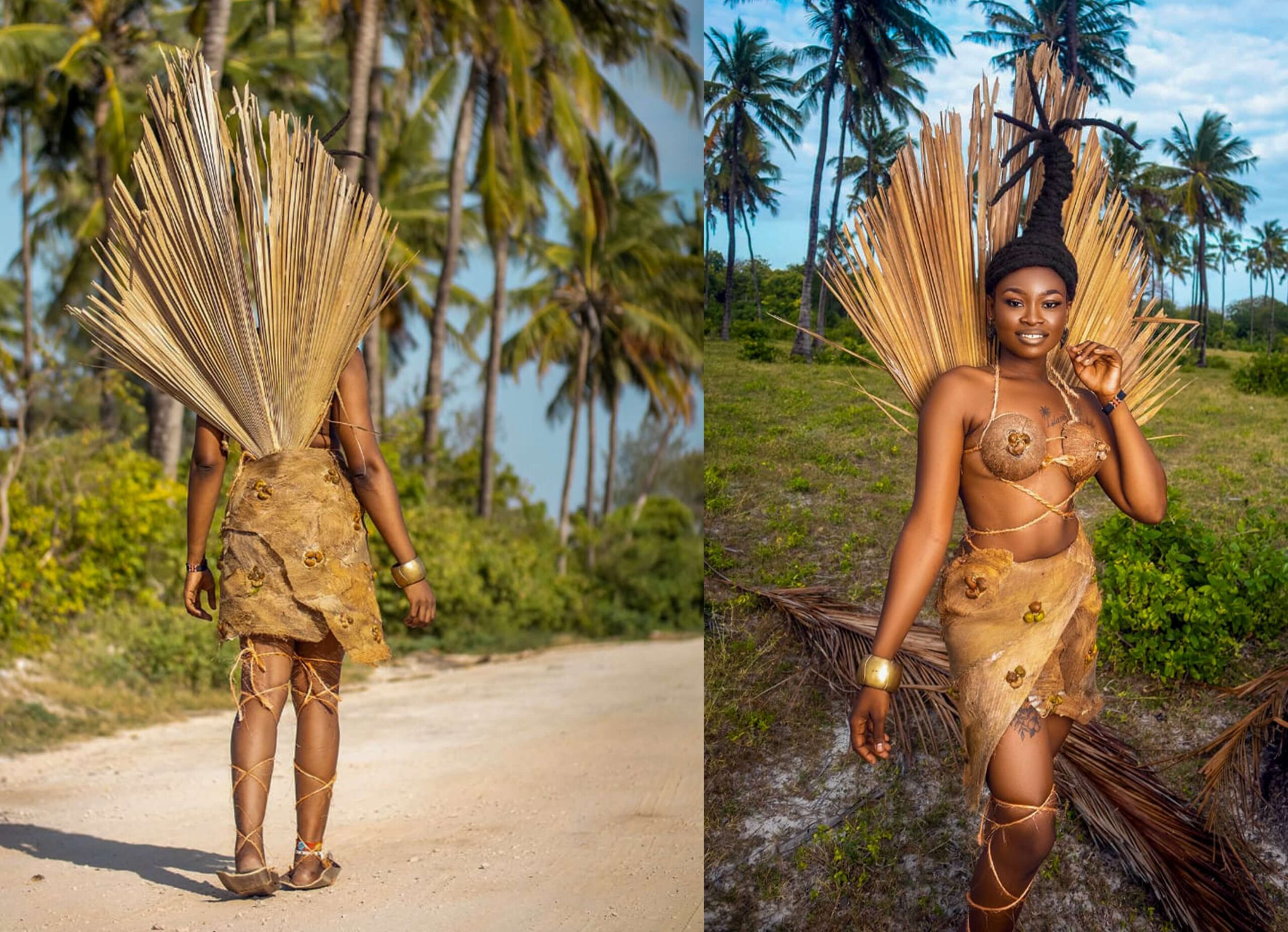By Velma Pamela
Environmental concerns are increasingly shaping the fashion sector across Africa. According to the African Circular Economy Alliance, launched in 2021, over 40 percent of garments in several African countries are imported secondhand, with much of it ending up in landfills due to poor quality or oversupply.
According to the United Nations Environment Programme’s 2020 report, Sub-Saharan Africa generates more than 17 million tons of waste annually, with textile and plastic waste accounting for an increasing proportion of this waste.
Along sections of the East African coastline, discarded fishing nets lay in knots among the rocks. Plastic bag remnants cling stubbornly to seaweed, their colors barely distinct from the surrounding marine flora. Cigarette butts, bottle caps, and candy wrappers litter the beach. The waste blends into the surroundings, and beachgoers often overlook it as the tide sweeps it back out to sea.
28-year-old Cynthia Kabibi grew up on Kenya’s northern coast. Spending time at the beach was a regular part of her life, and it influenced the direction of her work.
“I love the beach so much,” Kabibi said. “But every time I go there, I see it is very dirty… plastic, cigarette butts, candy wrappers, and other discarded items. Being an environmental student, I knew this wasn’t how things should be.”
While studying environmental science at Pwani University in 2017, she worked as a fashion model and began making crochet items for students and other models.
Initially, she purchased her raw materials from local secondhand shops. But after frequent visits to the beach, where plastic and other garbage were usually present, she started picking up and storing the discarded items. Over time, she began experimenting with the materials in her designs.
The idea for Kabibi’s Touch began to take shape in 2020 during the COVID-19 lockdown. With more time on her hands and fewer distractions, she focused on expanding her skills and turning her passion into something bigger.
Her technique begins with collecting waste from the beaches. She collects mosquito nets, abandoned plastics, ropes, and fishing nets, which are then cleaned and repurposed for use.

Other types of marine debris commonly found on the shoreline include flip-flops, toothbrushes, broken plastic crates, styrofoam pieces, and single-use packaging and consumer waste that moves from inland or is swept ashore by the waves.
“I don’t like to start before I have an idea,” she says. “I’ll draw it, write notes, see what materials I have, then I start creating.”
She has created stunning evening gowns adorned with reworked fishing nets, corsets crafted from reused mosquito nets, and accessories such as earrings and belts made from bottle caps, beads, and ropes. One of her most remarkable designs was a dramatic, layered dress made from colorful plastic bits, with wings transformed into something resembling ocean waves.
Her initiative contributes to Africa’s developing circular fashion movement. According to the African Development Bank (2022), the continent’s green and creative industries are growing as promising areas for innovation and youth employment. In Kenya, initiatives to promote sustainable fashion and repurposing of waste are gaining momentum, with more designers adopting upcycling and eco-friendly production methods.
When the designs are complete, she models them herself or works with other models, photographers, and stylists. Many of her most notable works are national or cultural costumes tailored for beauty pageants—bold, statement-making pieces that combine traditional African aesthetics with modern, eco-conscious themes.
The 2023 TUZA Awards nominated Kabibi for Mijikenda Youth Ambassador, and in March, 2025, she joined the panel to discuss sustainable entrepreneurship in the fashion industry. TUZA Awards, held annually in Kilifi County, celebrate individuals and organizations driving innovation in sustainability, eco-fashion, and marine conservation across Kenya’s coast. In 2024, a model wearing one of her designs won the Miss Fashion Kenya Creative Wear crown.
Kabibi’s work has also influenced young creators. Musembi Odanga, a 20-year-old crochet artist and close friend, views her brand as part of a broader effort to promote sustainability in African design.
What sets Kabibi apart, she said, is her eco-consciousness. “The value proposition of Kabibi’s Touch is that she uses eco-friendly materials; everything she uses to make her outfits has to be sustainable,” she explains.
“She goes and picks her raw materials from the ocean and makes valuable art. She gives the ocean a new life.”
Although Kabibi creates her designs from recycled materials, people frequently question their pricing.
“People don’t understand why it’s “expensive.” But it’s not just a price tag; it’s the time, the effort, the message,” she explained. “I like to say it’s not expensive; it’s costly.”
Kelly Robert Banda, an advocate for the High Court of Kenya and an environmental consultant, pointed out the broader importance of maritime protection.
“The marine ecosystem adds so much value to our environment,” says Banda. “Through fishing, communities earn a livelihood. It’s a huge industry that must be safeguarded, from policy development to addressing direct environmental hazards.”
Banda highlighted the often-overlooked consequences of plastic pollution, not only on marine life but also on human health. “You can imagine you are taking fish, and this fish has eaten plastic waste that maybe you deposited in the sea. Then it comes back, and you eat it. That has serious health implications,” he warned.
This issue is not unique to Kenya. Coastal nations across the continent are dealing with the growing problem of marine pollution. Large amounts of plastic debris are routinely dumped into the Gulf of Guinea in Ghana, posing a significant threat to biodiversity and the livelihoods of local fishermen. Plastic garbage choking streams and harming marine habitats poses a comparable challenge to towns throughout Nigeria’s Atlantic coast.
According to the Nigerian Conservation Foundation, in a statement made on June 3, 2023, poor waste management in coastal towns like Lagos significantly contributes to ocean pollution, putting both marine life and public health at risk.
Banda believes that individual action must be paired with robust regulatory frameworks to ensure accountability, especially within industries such as shipping. “It’s not just about creating policies; it’s about implementing them effectively. And as individuals, we also need to take full responsibility: don’t leave plastic waste on the beach, because when tides come in, they sweep it back into the ocean.”
He also acknowledged the creative sector’s role in addressing the crisis. “There are people who pick up waste and turn it into something beautiful, something that can sell, like sandals or artifacts. So as much as there’s economic value in repurposing that waste, we must remember that prevention is just as important as innovation.”
Kabibi uses media and public speaking to convey how environmental deterioration impacts both nature and people, particularly in coastal towns. She has utilized local radio stations, such as Blue Radio and Coco FM, to raise awareness about the risks of plastic pollution and textile waste.
Beyond fashion, she wants to use her brand to help others. She envisions creating spaces for young people and women to learn skills that can support them financially and emotionally.
“I would love to assist people with my skills for them to get from one point to another, to grow stronger in mind, and also in the pockets,” she said.
Kabibi is building a model that combines environmental awareness, creativity, and social impact. For her, using waste to make clothing is not just a design choice; it’s a way of saying that transformation is possible and that beauty can emerge from what others discard.
“This isn’t just fashion. This project is transformation,” Kabibi concluded.
bird story agency
Cynthia Kabibi Baha, a designer, model, and environmental science graduate, addresses marine litter in Kenya through her fashion brand, Kabibi's Touch.
Utilizing waste materials collected from beaches and second-hand markets, she repurposes discarded fishing nets, plastics, and fabrics into garments, contributing to the growing circular fashion movement in Africa.
Her designs not only advocate for environmental awareness and sustainability in the fashion industry but also emphasize the transformation of waste into art, highlighting the serious impact of plastic pollution on marine ecosystems and human health.
Kabibi's initiative aligns with innovative and sustainable practices in Africa's fashion sector.
Her work has catalyzed eco-conscious creativity among young designers, as seen in her influence on fellow artist Musembi Odanga.
Despite facing misconceptions around pricing, Kabibi emphasizes the value, effort, and environmental message behind her creations, advocating for a shift in perception towards sustainable fashion.
She has been recognized by platforms like the TUZA Awards for her contributions to eco-fashion and marine conservation, further leveraging media to raise awareness on the environmental impact of waste.
Environmental consultant Kelly Robert Banda underscores the urgent need for robust regulatory frameworks to manage plastic pollution and protect marine ecosystems, noting the direct influence of coastal litter on public health and biodiversity.
Kabibi's work, alongside media advocacy, aims to incite both individual responsibility and policy changes, encouraging a fusion of art, environmental consciousness, and social impact.
Through her brand, she aspires to empower others, especially women and youth, by offering skill development opportunities, underscoring her vision of beauty arising from transformation and sustainable practices.






